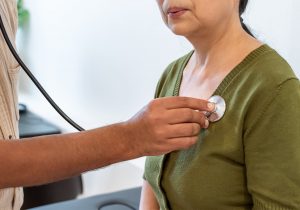
November is Lung Cancer Awareness Month
Lung cancer is a matter of life and breath. Every breath becomes a battle with this form of cancer that starts in the lungs and may spread to the lymph nodes and other organs in your body. There are different types and stages of lung cancer—and they’re each treated differently—but one thing is for certain: lung cancer screenings can save your life. Each November, fresh hope and help are in the air with the arrival of Lung Cancer Awareness Month. It’s the perfect time to be proactive by raising awareness about lung cancer and the importance of research, life-saving screenings, and reducing your risk. Show your support by learning about the prevalence of the problem, the different types of lung cancer, the main lung cancer symptoms, and ways to protect yourself. Then, discover how various therapies and innovations in how to treat lung cancer have truly been a breath of fresh air.
Airing the truth about the spread of lung cancer
Lung cancer may be the second most common kind of cancer, but it’s the number one cause of cancer deaths worldwide, killing more people each year than breast, colon, and prostate cancers combined. In 2022, more than 236,000 people are expected to be diagnosed with lung cancer in the United States alone. If you think that lung cancer only happens to smokers, that’s not the case. In fact, lung cancer can even happen to people who’ve never touched a cigarette but are in close proximity to family or friends who smoke. While there’s no denying that smoking is the leading cause of lung cancer cases, the disease can also seem to appear out of thin air due to exposure to secondhand smoke, toxic chemicals, radon, and air pollution. Luckily, the number of new lung cancer cases has steadily declined over the last decade as more people have quit smoking. And, with more people getting lung cancer screenings that detect cancer early when it’s most treatable, along with new approaches in how to treat lung cancer, the lung cancer survival rate has steadily increased every year.
The types and stages of lung cancer
While many cancers can affect the lungs, the two main kinds of lung cancer are non-small cell lung cancer and small cell lung cancer. The way that each grows, spreads, and responds to treatment is very different, which makes a significant difference in the course of care:
- Non-small cell lung cancer – This is the most common lung cancer, comprising around 85% of cases. These are further divided into categories based on the types of cells in the tumors. They generally have a more favorable outlook.
- Small cell lung cancer – Making up fewer than 15% of lung cancer cases, almost all of them are due to smoking. This is the faster-growing and more aggressive type of lung cancer, as well as the more difficult one to treat.
Just as important as the type of lung cancer is its stage. The stages of lung cancer are based on the size and location of the tumor, as well as whether the cancer has spread. Knowing the stage of your lung cancer helps determine your treatment options. The stages range from Stage 0 to Stage 4. The higher the stage, the more the cancer has spread.
Breaking the silence about lung cancer symptoms
Most of the time, lung cancer is the strong and silent type. That’s because symptoms tend to stay silent until the disease has come on strong and reached an advanced stage. Yet, some people have symptoms at an earlier stage. If you experience any of the following symptoms, visit your SignatureMD-affiliated doctor as soon as possible because early detection can save your life. The most common lung cancer symptoms include:
- Coughing that won’t go away
- Shortness of breath
- Wheezing
- Chest pain
- Coughing up blood
- Constant fatigue
- Unexplained weight loss
Clearing the air about prevention
Prevention is the best protection against lung cancer. Take advantage of Lung Cancer Awareness Month to take control of your health by reducing your risk for lung cancer with the following healthy habits:
- Don’t smoke
- Quit smoking
- Stay away from secondhand smoke
- Avoid toxic chemicals at work
- Get your home tested for radon
- Eat a healthy, balanced diet full of a rainbow of fruits and vegetables
- Get regular exercise
- Consider a lung cancer screening
Breathe easy about how to treat lung cancer
According to the American Cancer Society, the outlook is more positive than ever for treating and beating all stages of lung cancer. The promising increase in the lung cancer survival rate is mainly due to improvements in both tests to diagnose lung cancer and therapies that target the disease. There are several types of treatment for lung cancer based on the type of lung cancer and how far it has spread. The treatments for non-small cell lung cancer include some combination of surgery, chemotherapy, and radiation. For people with small cell lung cancer, the most effective options are chemotherapy and radiation. In addition, new treatments involving immunotherapy and targeted drug therapy are contributing to the rapidly growing lung cancer survival rate.
During Lung Cancer Awareness Month and beyond, spread the word about lung cancer to help breathe new life into the fight against the disease.